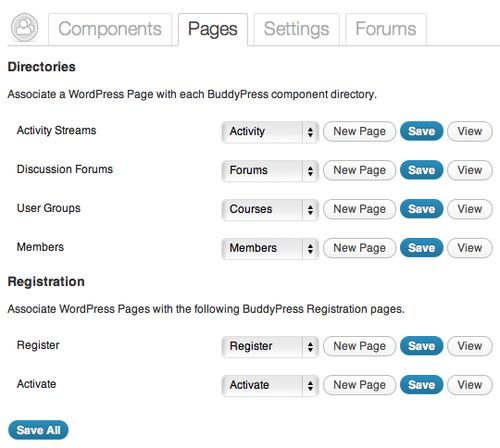The BuddyPress (BP) Courseware plugin by ScholarPress transforms our WordPress site into a learning management system. This plugin provides educators with the ability to post and organize course content, assignments, bibliographies, and schedules. BP Courseware works by extending the BuddyPress group functionality. Each courseware-enabled group receives a courseware dashboard where teachers and students can quickly access and post course content. The BP Courseware plugin is ideal for managing multiple courses by the same instructor or for an entire academic department.
In this chapter we'll cover how to install and configure the BP Courseware plugin. Once the plugin is installed, we'll develop content for a sample courseware course by adding course information, posting assignments, grading student assignments, creating a bibliography, and managing the course calendar.
As BP Courseware is a plugin that runs atop BuddyPress, we must have already installed, activated, and configured BuddyPress as described in Chapter 5, Enhancing WordPress with Plugins.
To install BP Courseware, log in to the WordPress dashboard, hover over Plugins in the left sidebar, and choose Add New. Search for BuddyPress ScholarPress Courseware and install the plugin as described in Chapter 3, Enhancing WordPress with Plugins.
BuddyPress Courseware requires the Private Messaging BuddyPress component to be enabled. If you have disabled Private Messaging, as described in Chapter 5, Creating a Social Network with BuddyPress, you will be prompted to enable it before activating BuddyPress Courseware. To enable Private Messaging, log in to the WordPress dashboard and visit the BuddyPress Components screen.
While BuddyPress Courseware will work immediately, there are a number of settings that can be adjusted to ensure that the plugin meets our needs. To access the BuddyPress Courseware settings, log in to the WordPress dashboard, hover over BuddyPress in the left sidebar, and select Courseware.
BP Courseware integrates with BuddyPress groups for course management. By default, we must enable courseware individually for each group. Checking the Enable Courseware globally checkbox will turn courseware on for all new groups. This is useful if groups are used exclusively for course management.
If you intend to use BuddyPress groups for other purposes, such as student project collaboration, the Enable Courseware globally option should remain unchecked. In this scenario each group will require enabling courseware manually. To do so, follow the instructions given in the Enabling BP Courseware section later in the chapter.
Within BP Courseware we are able to define users as either teachers or students. By enabling the Collaboration settings option, any site user with a teacher role has the ability to edit and add courses, assignments, and schedules.
When students submit an assignment their response is public to all site users. By enabling the Make assignment responses private feature, student responses will be visible only to the teachers and the student who has completed the assignment.
The default BuddyPress Courseware Gradebook format is numeric. Within the Gradebook default grade format settings we are able to choose between numeric, letter, or percentage grading for assignments.
BP Courseware utilizes the BuddyPress group feature for course content. While the term Groups makes sense in the context of a standard BuddyPress installation, it can be confusing when using BuddyPress Courseware as a learning management system. To prevent this confusion, I find it helpful to rename the Groups page to Courses.
To rename Groups:
- Log in to the WordPress dashboard.
- Create a new WordPress page titled Courses by hovering over Pages in the left sidebar, and choosing Add New. Title the page Courses, leaving the page content blank, and click on the blue Publish button.
- Adjust the BuddyPress page settings by hovering over BuddyPress in the left sidebar and selecting the Pages tab. In the menu next to User Groups, select the Courses option and click on the Save button.

- Delete the Groups page by clicking on Pages in the left sidebar. From the All Pages screen, hover over the Groups page and click on the red Trash link.

In Chapter 2, Setting up our Class Site, we created a page titled Home and set it as the static front page of our WordPress site. Using the BuddyPress Courseware plugin, we may wish to enable our Courses page as the site's front page. Doing so will allow students to quickly access course information and prevent confusion regarding how to find the courseware dashboard.
To enable the Courses page as our site's home page:
- Log in to the WordPress dashboard.
- If you have not already done so, create an empty page titled
Blog, as described in Chapter 2, Setting up our Class Site. - Hover over Settings in the left sidebar and select the Reading tab.
- From the Reading Settings screen, select Front page displays | A static page option.
- Select Courses from the Front page menu choices and Blog as the Posts page.

